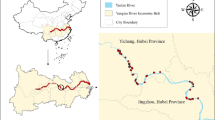Abstract
The modelling of the time to sale for residential property is complex because of complicating factors such as properties changing their price or being withdrawn from sale, changing market conditions, the presence of submarkets, whether the property represents ‘good value’, and seller motivation. This paper analyses a data set of modern properties that contains information about their previous selling price. This information is used to value the properties instead of the standard method of regressing on the physical characteristics of the properties. A survival analysis approach is then used to model the time to sale with this time being adjusted to take into account changing market circumstances and alterations to the list price during this period. It is found that the hazard rate for selling a property is approximately constant for the first 9 months a property is marketed.












Similar content being viewed by others
References
Allen MT, Rutherford RC and and Thomson TA (2009). Residential asking rents and time on the market. J Real Estate Financ 38 (4): 351–365.
Anglin PM, Rutherford R and Springer TM (2003). The trade-off between the selling price of residential properties and time-on-the-market: The impact of price setting. J Real Estate Financ 26 (1): 95–111.
Asabere PK, Huffman FE and Johnson R (1993). Mispricing and optimal time on the market. J Real Estate Res 8 (1): 149–156.
Biswas T and McHardy J (2007). Asking price and price discounts: The strategy of selling an asset under price uncertainty. Theor Decis 62 (3): 281–301.
Brint A (2009). Predicting a house's selling price through inflating its previous selling price. J Opl Res Soc 60 (3): 339–347.
CLG (2010). Communities and Local Government Housing Statistics, http://www.communities.gov.uk/corporate/researchandstatistics/statistics/subject/housingstatistics, accessed 30 March 2010.
Collett D (2003). Modelling Survival Data in Medical Research, 2nd edn. Chapman; Hall/CRC: London.
Cox DR and Oakes D (1984). Analysis of Survival Data. Chapman; Hall: London.
Cubbins JS (1974). Price, quality and selling time in the housing market. Appl Econ 6: 171–187.
Efron B (1981). Censored data and the bootstrap. J Am Stat Assoc 76 (374): 312–319.
Farmer A and Stango V (2004). Ask prices, offers, and time to sale in an online exchange. Economic Inq 42 (1): 14–28.
Jud G, Seaks T and Winkler D (1996). Time on the market: The impact of residential brokerage. J Real Estate Res 12 (3): 447–458.
Knight JR (2002). Listing price, time on market and ultimate selling price: Causes and effects of listing price changes. Real Estate Econ 30 (2): 213–237.
Marshall AW and Olkin I (2007). Life Distributions. Springer: New York.
McGreal S, Adair A, Brown L and Webb JR (2009). Pricing and time on the market for residential properties in a major UK city. J Real Estate Res 31 (2): 209–233.
Merlo A and Ortalo-Magné F (2004). Bargaining over residential real estate: Evidence from England. J Urban Econ 56 (2): 192–216.
Miller NG and Sklarz MA (1987). Pricing strategies and residential property selling prices. J Real Estate Res 2 (1): 31–40.
Pryce G and Gibb K (2006). Submarket dynamics of time to sale. Real Estate Econ 34 (3): 377–415.
RICS (2010). Royal Institute of Chartered Surveyors Housing Market Survey (November 2001 – February 2010), http://www.rics.org/uk, accessed 7 April 2010.
Suciu GP, Lemeshow S and Moeschberger M (2004). Statistical tests of the equality of survival curves: Reconsidering the options. In: Balakrishnan N and Rao CR (eds). Handbook of Statistics 23: Advances in Survival Analysis. Chapter 13, Elsevier; North Holland: Amsterdam, pp 251–262.
Taylor CR (1999). Time-on-the-market as a sign of quality. Rev Econ Stud 66 (3): 555–578.
Watkins CA (2001). The definition and identification of housing submarkets. Environ Plann A 33 (12): 2235–2253.
Yavas A and Yang S (1995). The strategic role of listing price in marketing real estate: Theory and evidence. Real Estate Econ 23 (3): 347–368.
Acknowledgements
The paper has been considerably improved by the referees’ comments, especially with regard to the proportional hazards modelling.
Author information
Authors and Affiliations
Corresponding author
Rights and permissions
About this article
Cite this article
Brint, A. Modelling a property's time to sale by inflating its previous selling price. J Oper Res Soc 63, 762–770 (2012). https://doi.org/10.1057/jors.2011.74
Received:
Accepted:
Published:
Issue Date:
DOI: https://doi.org/10.1057/jors.2011.74




